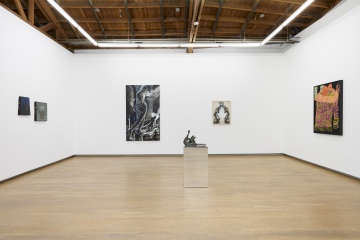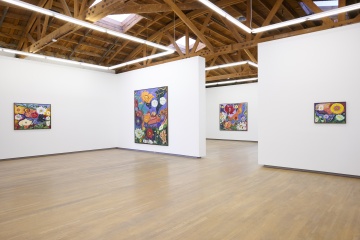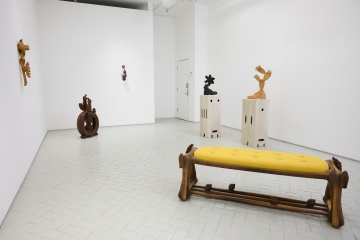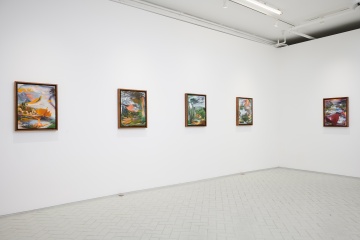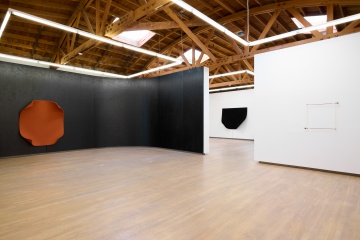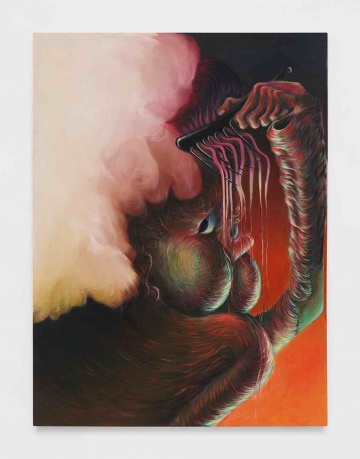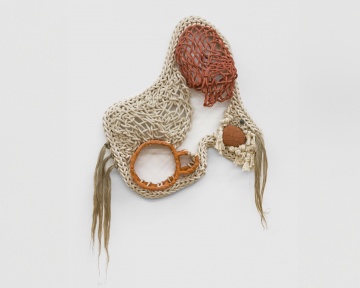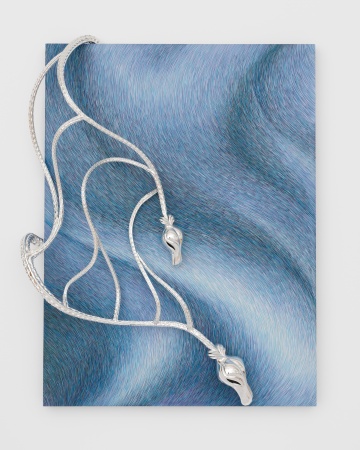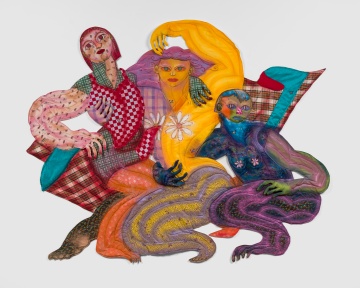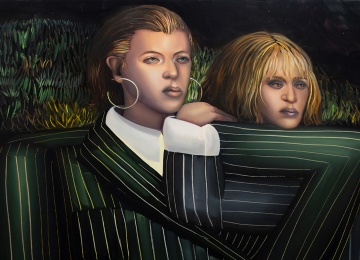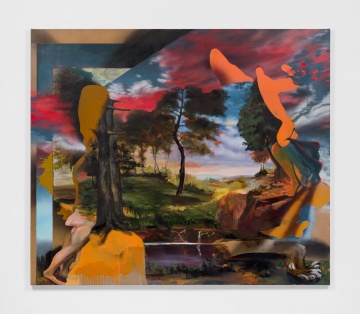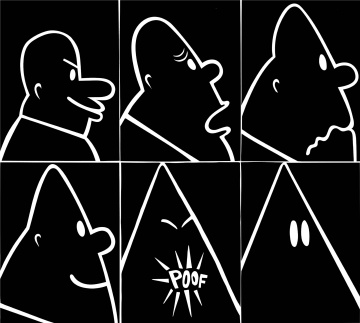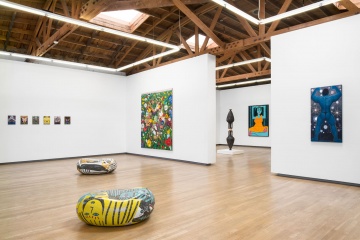Dabin Ahn, Alex Anderson, Avital Burg, Widline Cadet, Gabe Cortese, Annie Lapin, Ken Gun Min, Sabrina Piersol, Alexandria Tarver, and Summer Wheat
Midnight Gardens
January 11, 2025 - February 8, 2025
Nazarian / Curcio is pleased to present Midnight Gardens, featuring new works by Dabin Ahn, Alex Anderson, Avital Burg, Widline Cadet, Gabe Cortese, Annie Lapin, Ken Gun Min, Sabrina Piersol, Alexandria Tarver, and Summer Wheat. Midnight Gardens brings together a group of artists exploring landscapes, still lifes, and botanical scenes shrouded in the quiet mystery of night. As the dim light cloaks familiar spaces, the works shift from representation to abstraction, transforming gardens and plants into surreal environments where forms dissolve and take on anthropomorphic qualities. Translated through painting, sculpture, and photography, the garden becomes more than a physical space—it becomes a site for reimagining the world, where nature’s elements blur into the unfamiliar and the mysterious. The interplay of shadow and subtle light charges these nocturnal scenes with a sense of intrigue, as the night itself becomes a transformative force, revealing hidden layers of meaning and new possibilities.
Dabin Ahn (b. 1988, Seoul, Korea; lives and works in Chicago, IL) creates paintings rooted in realism, often depicting flora, fauna, vessels, candles, and ceramic fragments, each serving as a representation of the self. Ahn’s work also incorporates sculptural elements, featuring hand-built frames that part to reveal images along the canvas edges. Light plays a central role in the artist’s lexicon, suggesting an illuminating presence even when its source is hidden. These elements collectively blur the boundaries between the material and the imagined, evoking an emotional depth reflective of the human experience.
Ahn received his BFA and MFA in painting from the School of the Art Institute of Chicago. His work has been exhibited at Harper’s, New York, NY; Christie’s, New York, NY; Marvin Gardens, New York, NY; Selenas Mountain, Ridgewood, NY; Long Story Short, New York, NY; Sargent’s Daughters, Los Angeles, CA; The Hole, Los Angeles, CA; Make Room, Los Angeles, CA; Ochi, Los Angeles, CA; The Green Gallery, Milwaukee, WI; Edgewood College Gallery, Madison, WI; Mindy Solomon, Miami, FL; Hyde Park Art Center, Los Angeles, CA; Research House for Asian Art, Chicago, IL; ARTRUSS, Chicago, IL; among others.
Alex Anderson (b. 1990, Seattle, WA; lives and works in Los Angeles, CA) uses ceramics to explore existence, consciousness, and life's metaphysical dimensions. His work examines identity and psychology, focusing on the human body as both physical matter and a vessel for animating energy and reflecting on the human experience. Drawing from energy work and meditation, Anderson investigates belief systems centered on the human spirit. His research spans diverse cultures, histories, and regions, inspiring motifs like halos, infinity, auras, the sun, portals, and various botanical forms. These elements, combined with geometric patterns and a focus on energy, aim to materialize the forces of spirit through ceramics—a medium he sees as analogous to human life.
Anderson received his BA from Swarthmore College and his MFA from the University of California, Los Angeles. He also studied at the Jingdezhen Ceramic Institute in Jingdezhen, China, and was awarded a Fulbright Grant in affiliation with the China Academy of Art in Hangzhou. His work has been exhibited at numerous galleries and museums, including the Orange County Museum of Art, Costa Mesa, CA; the Museum of Arts and Design, New York, NY; The Long Beach Museum of Art, Long Beach, CA; the American Museum of Ceramic Art, Pomona, CA; Human Resources, Los Angeles, CA; Venus Over Manhattan, New York, NY; Gavlak Gallery, Los Angeles, CA, and Palm Beach, FL; and Jeffrey Deitch Gallery, Los Angeles, CA, and New York, NY. Internationally, his work has been shown at the Public Gallery, London, UK; Gallery COMMON, Tokyo, Japan; and Baik Art, Seoul, South Korea.
Avital Burg (b. Jerusalem, Israel; lives and works in Brooklyn, NY) creates self-reflective still-life paintings rooted in her deep connection to the natural world. In recent years, Burg has focused on crafting highly textured works that feature everyday imagery, particularly wildflowers gathered from the edges of her Brooklyn neighborhood. Using plant life as a metaphor for the human body, her paintings emerge from a slow, labor-intensive process, often involving prolonged observation of her subjects. Time is a central theme in her work, as her botanical subjects undergo natural decay during the rendering process, encapsulating the passage of time within a static picture plane.
Burg attended the Bezalel Academy of Art and Design, Jerusalem; the Hatahana School of Figurative Drawing and Painting, Tel Aviv; the Slade School of Art, London; and the New York Studio School. Her solo exhibitions include Browse & Darby in association with Crean and Company, London, UK; Pamela Salisbury Gallery, New York, NY; Slag Gallery, New York, NY; and Neve Schechter Gallery, Tel Aviv, ISR. Her work was also part of two-person exhibitions at Arts at AJU, Los Angeles, CA, and Club Cultural Matienzo, Buenos Aires, Argentina. She was the May 2022 artist in residence at the Interlude Residency in NY, and at the Peleh Residency in California in 2019.
Widline Cadet (b. Pétion-Ville, Ayiti; lives and works in Los Angeles, CA) has a multidisciplinary practice rooted in photography that extends to video, sound, sculpture, performance, and installation. Her work draws on her family’s lived experience of immigrating from Haiti to the United States to explore the complexities of Black diasporic life and survival. Using signifiers such as local flora, architectural elements, and the distinctive landscapes of Southern California, Cadet forges a visual connection between her birthplace in Haiti and her current home in Los Angeles. Drawing inspiration from personal memories, Haitian culture, folklore, and an archive of family photographs and videos, Cadet creates speculative images that traverse specific moments in time and geographic spaces. Through these works, she examines inherited cultural beliefs and the ways in which Black diasporic life continues to shape her identity and experiences.
Cadet earned her BA in studio art from City College of New York and an MFA from Syracuse University. She is a recipient of several fellowships and residencies, including the 2020–21 artist residency at the Studio Museum in Harlem, the 2020 Museum of Contemporary Photography’s Snider Prize, and the 2013 Mortimer-Hays Brandeis Traveling Fellowship. Recent solo exhibitions include Huis Marseille, Amsterdam, NL and group exhibitions at the Whitney Museum of American Art, New York, NY; Somerset House, London, UK; Fotografiska Museum, New York, NY; Milwaukee Art Museum, Milwaukee, WI; and MoCP, Chicago, IL and Los Angeles County Museum of Art. Her work is held in the collections of major institutions such as the Whitney Museum of American Art, New York, NY; Museum of Contemporary Photography, Amsterdam; Studio Museum in Harlem, New York, NY; Los Angeles County Museum of Art, CA; and the Block Museum at Northwestern University, Chicago, IL. Cadet’s work is currently featured in Flow States: La Trienal at El Museo del Barrio, New York, and will be included in upcoming exhibitions at the International Center of Photography, NY and the 2025 Liverpool Biennial.
Gabe Cortese (b. 1994, Key West, FL; lives and works in Providence, RI) is a painter and draftsman exploring intersectional identities, queer mythologies, and the representation of the male body in art. As a Queer Latino man, he examines the societal pressures and roles that have shaped his identity. Influenced by his childhood near Disney World in Orlando, Cortese incorporates the theatrical and illustrative language of fairy tales to construct imaginative, dreamlike worlds. His works layer personal history with elements of mystery and fantasy, challenging conventional depictions of masculinity and identity. Through his art, Cortese celebrates the complexities of queer identity while inviting viewers to reflect on themes of selfhood and representation.
Cortese received his BFA and MFA from the University of Central Florida. Recent solo exhibitions include Cadet Capela, Paris, France; G/art/en Gallery, Como, Italy; and M+B, Los Angeles, CA. Recent group exhibitions include Marian Cramer Projects, Netherlands; Nazarian Curcio, CA; G/art/en Gallery, Italy; Woaw Gallery, China. His work is also in the collection of the Institute of Contemporary Art, Miami; the Orlando Museum of Art, FL; X Museum; and the Tom of Finland Foundation."
Annie Lapin (b. 1978, Washington D.C.; lives and works in Los Angeles) is known for her continuous exploration of painting genres, blending landscape, figuration, and abstraction. Drawing from a variety of visual references—including her personal photo archive, online media, and iconic works from art history—Lapin creates paintings that merge fractured yet familiar forms into cohesive representations of the world. Her practice integrates both digital and analog techniques, beginning with pours of paint and graphite to build scenes where abstraction and hyper-realistic detail coexist. Figures and environments flow into one another, reflecting the fragmented nature of perception. By combining elements of Western landscape painting with photographic blur, her works capture humanity’s ongoing desire to make sense of the world through conflicting myths.
Lapin received her MFA from the University of California, Los Angeles, her Post-Baccalaureate Certificate from the School of the Art Institute of Chicago, and her BA from Yale University. Recent solo exhibitions include Nazarian / Curcio, Los Angeles, CA; Christine König Galerie, Vienna, AT; Miles McEnery Gallery, New York, NY; and Museum of Contemporary Art, Santa Barbara, CA. Group exhibitions include the USC Fisher Museum of Art, Los Angeles, CA; Bruce Museum, Greenwich, CT; Hilger Contemporary, Vienna, AT; Museo di Capodimonte, Naples, IT; and Neuberger Museum of Art, Purchase, NY. Lapin’s work is held in the collections of the High Museum of Art, Atlanta, GA; Los Angeles County Museum of Art, Los Angeles, CA; Nerman Museum of Contemporary Art, Overland Park, KS; Rubell Family Collection, Miami, FL; and Zabludowicz Collection, London, UK.
Ken Gun Min (b. 1976, Seoul, South Korea; Lives and works in Los Angeles, CA) creates paintings that are informed by his experience as a queer Asian man living in Los Angeles and Seoul. His landscapes reinterpret storied urban sites into lush utopias, employing a mixture of Western-style oil paints, Korean pigments, embroidery, and beading on canvas. Blending utopia and dystopia, his work highlights often untold narratives in a powerful social critique. Min pulls a range of references into the work to explore how power, race, and sexuality play into both local and global geopolitics. By exploring both contemporary and historical moments, his paintings expand outward from Min's personal life to address sublime encounters of splendor and darkness in human experience.
Ken Gun Min studied Western painting and art history at Hongik University, Seoul, Korea, and received his MFA from the Academy of Art, University of San Francisco. Recent solo exhibitions include MCA Denver, Denver, CO; Shulamit Nazarian, Los Angeles, CA; and Gae Po Project Space, Seoul, KR. Select group exhibitions include Craft Contemporary Museum, Los Angeles, CA; Utah Museum of Contemporary Art, Salt Lake City, UT; Torrance Art Museum, Torrance, CA; Albertz Benda, New York, NY; M+B Gallery, Los Angeles, CA; Lyle and King, New York, NY; and Lehmann Maupin, Seoul, KR. Min’s work is held in the collections of the Institute of Contemporary Art, Miami, FL; Los Angeles County Museum of Art, CA; Speed Museum of Art, Louisville, KY; CCS Bard, Hessel Museum of Art, Bard College, Annandale-on-Hudson, NY; JP Morgan Chase Art Collection; and X Museum, Beijing, China. Min has a forthcoming solo exhibition at the Savannah College of Art and Design in 2025 and a project at the Denver Art Museum in 2025.
Sabrina Piersol (b. 1995, Greenwich, CT; lives and works in Aspen, CO) is a Colorado-based painter exploring the intersection of abstraction and representation. Her work is deeply informed by early 20th-century American painting traditions, as well as the fragmented structure of Classical Greek Sapphic poetry. Piersol balances abstract forms with explicit references to nature, maintaining accessibility while pushing the boundaries of perception. Her paintings explore themes of desire, temporality, fluidity, and speculative extrapolation. Each piece invites viewers to envision alternate pasts and possible futures, creating spaces for reflection and transformation.
Piersol received her BA from Colorado College and her MFA from the University of California, San Diego. Select solo exhibitions include Sow & Tailor, Los Angeles, CA; Edge Art Space, Turin, IT; the University of California, San Diego; Permanent Storage Projects, Los Angeles, CA; and Weber Rations, Los Angeles, CA. She has participated in group exhibitions at Artemin Gallery, Taipei, Taiwan; High Bay Gallery, New York, NY; Sow & Tailor, Los Angeles, CA; 1969 Gallery, Ibiza, Spain; Techne Art Center, San Diego, CA; Friend of a Friend, Denver, CO; the University of California, San Diego, CA; and False Cast Gallery, Los Angeles (2021).
Alexandria Tarver (b. 1989, Houston, TX; lives and works in New York City, NY) recontextualizes the traditional floral motif, placing it between memory, idealization, and presence. Starting with careful observation of an arrangement, Tarver creates detailed pencil drawings before transferring her compositions onto oil panels. Drawing from historical movements such as Post-Impressionism, American Tonalism, New England mid-century representationalism, and gestural abstraction, she constructs her paintings in layers. The electric blue of twilight contrasts with the warm tones of the flowers, shifting into evening haze or dissolving into the deep purple-black of the night sky as seen from the city’s concrete landscape, ever in search of solace.
Tarver received a BFA from New York University in 2011. She has held solo exhibitions at Deli Gallery, NY. Group exhibitions include GRIMM Gallery, London; Marinaro Gallery, NY; Public Gallery, London; UncleBrother, NY; Arsenal Gallery, NY; Et Al. etc., San Francisco; Danziger Gallery, NY.
Summer Wheat (b. 1977, Oklahoma City, OK; lives and works in Brooklyn, NY) creates vibrant paintings and immersive installations that merge figuration, abstraction, and the history of materiality. Drawing from sources ranging from ancient art to modernist abstraction, her work examines labor, leisure, commerce, and class through archetypes such as farmers, hunters, and bankers. Wheat envisions worlds where time collapses, creating equal spaces where all individuals, regardless of status, share moments of work and rest. Her labor-intensive process critiques gender and class inequality, elevating both traditional and unconventional roles. With expressive use of color and unique techniques—using tools like syringes, scrapers, and cake-decorating materials—Wheat creates tactile, intuitive works that blur the boundaries between figure and ground, representation and abstraction, offering fresh perspectives on history and folklore.
Wheat holds a B.A. from the University of Central Oklahoma and an M.F.A. from Savannah College of Art and Design. Her solo exhibitions include the Nazarian / Curcio, Los Angeles, CA; Mint Museum, NC; Kemper Museum of Contemporary Art, MO; KMAC Museum, KY; Shulamit Nazarian, CA; Smack Mellon, NY; Henry Art Gallery, WA; and Oklahoma Contemporary, OK. Group exhibitions include Harper’s Books, NY; the Dallas Museum of Art, TX; Gio Marconi, Italy; and ICA Boston, MA. Her work is in collections at the Dallas Museum of Art, TX; de Young Museum, CA; Pérez Art Museum Miami, FL; Henry Art Gallery, WA; Mint Museum, NC; Speed Art Museum, KY; and Kemper Museum, MO. Awards include the Northern Trust Purchase Prize (2019) and the New York NADA Artadia Award (2016). In 2022, the Kansas City Museum commissioned Wheat to transform its Carriage House Beaux-Arts Conservatory into JewelHouse, a permanent site-specific artwork.

 Back to all Member Galleries
Back to all Member Galleries


